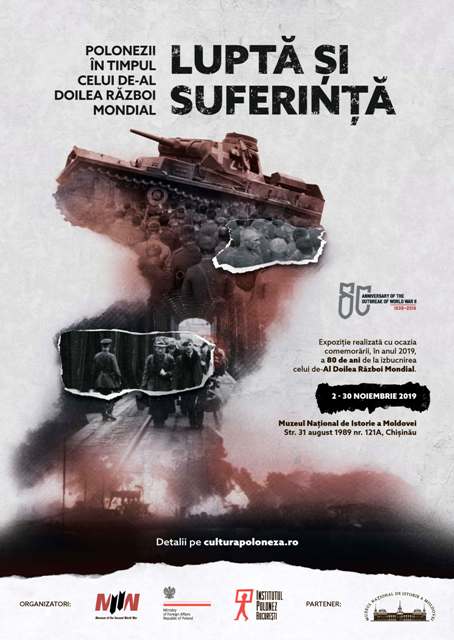Eighty years after the outbreak of World War II, Poland, its first victim, recalls the most dramatic armed conflict in world history. The exhibition which will be open in the hall of the National Museum of History of Moldova in Chișinău until the end of November speaks about this historical event.
The exhibition "Fighting and suffering. The Polish citizens during World War II" presents the fate of Poland during the war, which, on September 1, 1939, was attacked by Germany, and on September 17, by the Soviet Union.
Despite the numerical superiority of the occupiers, the Poles have had, throughout the entire world war, a strong armed resistance, both on the territory of their country and on other fronts and battlefields around the world.
The exhibition has on display 16 panels which present the most important moments from those days. Great attention is paid to the destinies of the civilian population. This rich material is represented by archive photographs obtained from the archives of different countries, including from the Romanian collections.
The story of the war drama, which was prepared by one of the most modern museums in the world - the World War II Museum in Gdansk, as well as by the Ministry of Foreign Affairs of the Polish Republic, will be presented in over 60 countries of the world.
The Polish Institute in Bucharest has prepared the Romanian version, enriching it with topics related to the Polish-Romanian relations during World War II, but also with photos obtained from the National Archives of Romania, which illustrates the lives of 60-100 thousand Polish refugees in Romania.
The exhibition has already been presented in the Romanian Senate in Bucharest, at the Museum of Bucovina in Suceava, as well the Museum of the Palace of Culture in Iași, at the initiative of the Polish Institute in Bucharest.
The Ambassador of the Polish Republic to Moldova, Bartlomiej Zdaniuk and the Deputy Director of the Polish Institute in Bucharest, Wojciech Mrozovsky, at the presentation of the exhibition on 15 November 2019, stressed the importance of intercultural relations between the Republic of Moldova and the Polish Republic as well as the need for such events for the contemporary society.
The drama of the Polish people during the second world conflagration, victim of the aggressive and expansionist politics of two totalitarian regimes - Nazi and Bolshevik - remains a broad and very actual topic.
The National Museum of History of Moldova, Chișinău, the hall on the ground floor, November 2-30, 2019. Free admission.
 31 August 1989 St., 121 A, MD 2012, Chisinau, Republic of Moldova
31 August 1989 St., 121 A, MD 2012, Chisinau, Republic of Moldova



















































